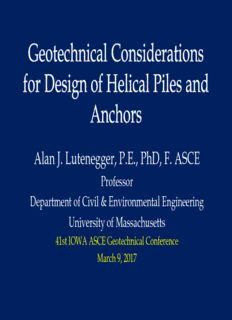
Geotechnical Considerations for Design of Helical Piles and Anchors PDF
Preview Geotechnical Considerations for Design of Helical Piles and Anchors
Alan J. Lutenegger, P.E., PhD, F. ASCE Professor Department of Civil & Environmental Engineering University of Massachusetts 41st IOWA ASCE Geotechnical Conference March 9, 2017 What are Helical Piles and Anchors? Characterization of Soil Parameters Understanding Effects of Installation Disturbance Understanding Roles of Shaft & Helix Torque-to-Capacity Ratios Section 1802.1 defines a Helical Pile as: “Manufactured steel deep foundation element consisting of a central shaft and one or more helical bearing plates. A helical pile is installed by rotating it into the ground. Each helical bearing plate is formed into a screw thread with a uniform defined pitch.” This Technology is Not New It is Over 180 Years Old 1st Recorded use of Screw-Piles was by Alexander Mitchell (1780-1868) in 1836 for Ship Moorings and was then applied by Mitchell as Foundations for Maplin Sands Lighthouse in England in 1838 Mitchell’s Screw-Pile Specifications for Maplin Sands Material – Cast Iron Shaft Diameter – 5 in. Screw (Helix) Diameter – 4 ft. Depth Below “Mudline” – 12 ft. Orientation - Vertical Pier & Bridge Construction
Description: